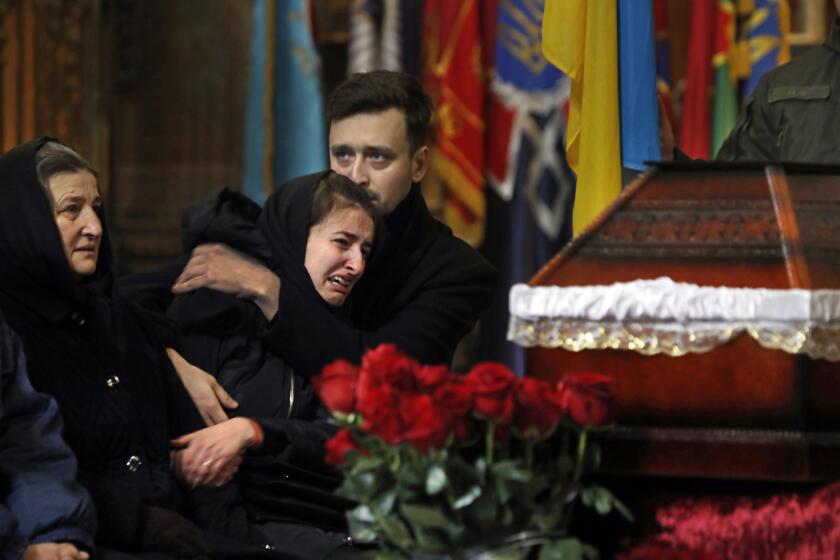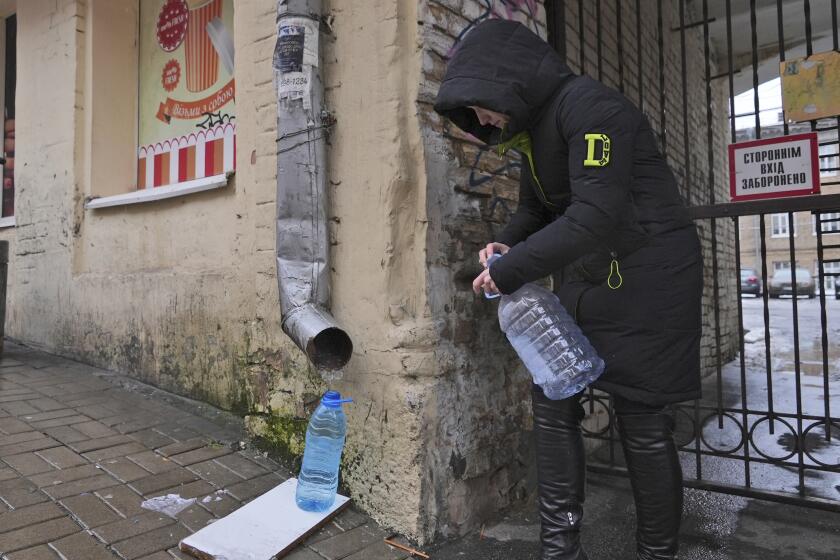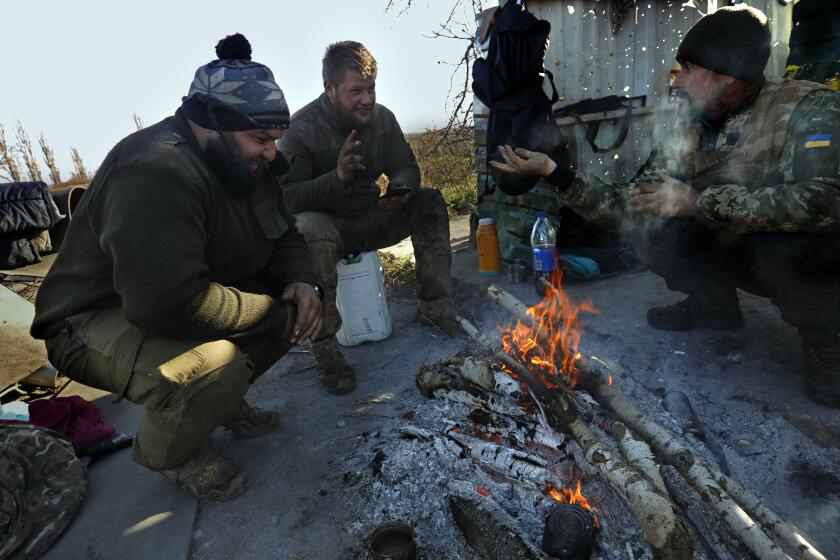Blankets, generators, medicine: Donors race to get aid to Ukraine as winter descends

- Share via
KYIV, Ukraine — When Russian forces launched a military campaign against Ukraine’s infrastructure nearly two months ago, they opened a front that carried the war along power lines, water mains and heating systems to homes, schools, offices and churches.
The government in Kyiv and the Western countries that have backed it with billions in military aid now are scrambling along with the United Nations and aid groups to get blankets, insulation, generators, medical supplies, cash and more essentials into the invaded country as winter looms.
Millions of Ukrainians are without regular access to heat, electricity and water in sub-freezing temperatures, Martin Griffiths, who heads the U.N. Office for the Coordination of Humanitarian Affairs, told the U.N. Security Council on Tuesday. Some have no access at all, he said.
“In Ukraine today, the ability of civilians to survive is under attack,” Griffiths said.
Despite a swift response and a high commitment from donors to a U.N. aid appeal, the needs are changing fast — and swelling. Much has been made of the need for diesel generators, whose buzzing motors create stopgap electricity for cellphone towers, restaurants and especially hospitals, which are the Ukrainian government’s highest priority.
Sporadic electricity has widespread impact. It deprives people of warmth from electric space heaters, steady light in the evenings and power for the millions of electronic devices and computers in a highly digitized country — and thus for livelihoods.
The Times’ Carolyn Cole is on the ground in Ukraine as residents prepare for winter’s cold amid Russian missile strikes against the nation’s infrastructure.
Strikes that disable deliveries of gas cut off the flames for furnaces and stoves. Kyiv Mayor Vitali Klitschko advised the capital’s residents to consider moving temporarily to rural areas, where basics like wood to burn for heat are more plentiful.
In the most desperate, hard-hit cities, some residents resort to scooping up dirty water from puddles in the street while water systems are temporarily disabled.
Saviano Abreu, a spokesperson for the U.N. humanitarian affairs office’s operation in Ukraine, said it pulled together hundreds of generators starting back in June, aware of the country’s harsh winters.
“With this situation and people living in damaged houses, we did know back then that we would have problems with heating, water and electricity, but not at this scale,” Abreu said, noting that supply chain issues posed obstacles to securing more equipment.
In Kyiv, the mayor says 70% of the Ukrainian capital has been left without power a day after Russia unleashed yet another devastating missile barrage.
“In the neighboring countries around Ukraine, it’s already not available, so we bring it from much farther at this point,” he said.
The U.N. Office for the Coordination of Humanitarian Affairs said last week that it would roll out its “largest cash assistance program in history” in Ukraine, totaling $1.7 billion for 6.3 million people. It said the experience in other countries has shown that distributing money directly to people to buy food, clothing and other basics is an effective strategy.
The U.N. Development Program is taking a different, longer-term approach. It’s seeking to fill requests from Ukraine’s government for technical equipment like power transformers, transformer substations, high-frequency stoppers, high-voltage inputs, surge arresters, industrial gas turbines and other items to help restore the electricity grid and energy systems.
“Together with the World Bank, [we’re] doing an assessment across Ukraine of all the damages and needs that have resulted from this targeting of the energy infrastructure,” Jaco Cilliers, the program’s acting resident representative in Ukraine, said. “We are in the process of putting that together, which includes obviously the larger-scale equipment that would be needed for the restoration.”
In Ukraine, a bleak winter lies ahead for combatants and civilians alike, as its army strives to maintain battlefield momentum against Russian forces.
“It’s a work in progress,” he said.
U.S. Secretary of State Antony J. Blinken last week announced $53 million in bilateral aid to help Ukraine acquire “critical electricity grid equipment” — on top of another $55 million for emergency energy sector support, such as for generators.
The European Union last month said it had made available 523 million euros (about $550 million) for humanitarian aid for Ukraine, and the U.S. has pledged $1.2 billion to an appeal by the U.N. humanitarian coordination agency.
“EU governments should now ensure that the announced aid actually reaches Ukraine as quickly as possible, without the many months of delay of previous packages,” said Christoph Trebesch, who leads a team behind the “Ukraine Support Tracker” at the Kiel Institute for the World Economy in Germany.
Start your day right
Sign up for Essential California for the L.A. Times biggest news, features and recommendations in your inbox six days a week.
You may occasionally receive promotional content from the Los Angeles Times.
A spokesperson for the EU’s executive commission said in an email that more than one-quarter of the funds the bloc made available for humanitarian aid has been allocated, mostly for a “winterized shelter response.”
The EU’s Civil Protection Mechanism also has shipped in fire trucks, ambulances, de-mining equipment, food supplies, mobile hospitals, excavators and portable prefabricated Bailey bridges, the spokesperson said.
The wish list of United24, a campaign launched by Ukrainian President Volodymyr Zelensky to secure private donations, is seeking ambulances, anesthesia machines and more than 7,800 “modular external fixators” — a medical device that helps broken bones heal properly.
Donors have come through in ways large and small. The German city of Dortmund just finished shipping a third batch of support to the southern Ukrainian city of Mykolaiv, including vans, trucks and other vehicles. From the small British town of Hertford, a truck makes a delivery every couple of months of medical supplies, food and — right now — Christmas gifts for children.
Avril Haines, U.S. director of national intelligence, says Russia’s war against Ukraine is running at a ‘reduced tempo.’
And despite Ukraine’s massive needs, there is too much of some kinds of aid. The Help Ukraine Center, a group of volunteers that brings in aid through its main warehouse in neighboring Poland, appealed to donors: “No more clothes please.” The center is shifting its focus to medical products, food and hygiene products.
Erik Heinonen, who works on the response of the Catholic Relief Services charity in Ukraine, said small items like a propane stove can have a huge impact.
“If you’re a mother with small children, you’re concerned about, you know, heating up food,” he said. “‘It would be great to give my children a bath’ ... the very basics of just getting through your day.”
More to Read
Sign up for Essential California
The most important California stories and recommendations in your inbox every morning.
You may occasionally receive promotional content from the Los Angeles Times.

















